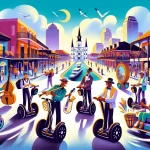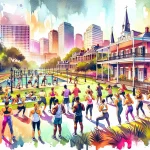The National WWII Museum in New Orleans stands as a beacon of education, preserving the invaluable history of World War II. It offers an unparalleled learning experience through immersive exhibits, cutting-edge technology, and comprehensive educational programs.
In This Article
TL;DR
- The museum captivates visitors with interactive exhibits, multimedia displays, and hands-on programs, providing an in-depth exploration of WWII.
- Unique offerings include virtual reality experiences, artifact restoration workshops, and living history demonstrations, enhancing the educational journey.
- Through its efforts, the museum has significantly contributed to public understanding and appreciation of WWII’s profound impact and the sacrifices made by those who served.
The Museum’s Founding and Mission
Envisioned by historian Stephen Ambrose and his colleague Gordon “Nick” Mueller in the early 1990s, the museum’s mission is to celebrate the American spirit, teamwork, optimism, courage, and sacrifice that led to victory in WWII. Partnerships with esteemed organizations like the Smithsonian Institution, the Library of Congress, and various universities have enabled the museum to curate an extensive collection of artifacts, oral histories, and archival materials related to WWII.
Core Exhibits and Their Educational Value
The museum’s core exhibits immerse visitors in the major campaigns and battles of WWII, providing a comprehensive understanding of the war’s chronology and global scale. The realistic environments, complete with soundscapes, lighting effects, and interactive displays, create a powerful and engaging learning experience.
“Road to Berlin”
This exhibit chronicles the European Theater of Operations from D-Day to the fall of Nazi Germany. Visitors can explore a recreated French village, experience the sights and sounds of the Normandy invasion, and witness the atrocities of the Holocaust through powerful testimonies and artifacts.
“Road to Tokyo”
The “Road to Tokyo” exhibit takes visitors on a journey through the Pacific Theater, highlighting the brutal island campaigns, the strategic importance of naval warfare, and the development of new technologies like the atomic bomb. Interactive displays allow visitors to explore the interiors of aircraft and ships.
Educational Programs and Workshops
The museum offers a wide range of educational programs and workshops tailored to different age groups and interests, designed to complement the museum’s exhibits and provide a deeper understanding of WWII’s historical, cultural, and technological aspects. These include guided tours, hands-on activities, interactive workshops for students, specialized workshops and lectures for adult learners, and programs covering topics such as the role of women in the war effort, WWII innovations, and the impact of the war on daily life.
Role of Technology in WWII Education at the Museum
The museum has embraced cutting-edge technology to enhance the educational experience for visitors. Virtual reality (VR) experiences transport users to iconic WWII battles, while interactive displays and touchscreens provide access to oral histories, archival footage, and detailed explanations of military equipment and strategies. The museum’s online resources and digital archives offer remote learning opportunities.
Special Events and Annual Commemorations
Throughout the year, the museum hosts a variety of special events and annual commemorations that further its educational mission, such as the annual D-Day commemoration featuring reenactments, lectures, and firsthand accounts. Other notable events include the Victory in the Pacific Day celebration and the International Holocaust Remembrance Day.
Contributions to Academic Research and Publications
The museum plays a vital role in furthering academic research and scholarship related to WWII. Its research facilities house an extensive collection of primary sources, oral histories, and archival materials. The museum has sponsored and collaborated on numerous research projects and publications, contributing to the advancement of WWII scholarship and fostering interdisciplinary collaborations.
Visitor Experience and Educational Impact
Testimonials and reviews consistently praise the museum’s immersive exhibits, knowledgeable staff, and engaging educational programs. Surveys and studies have demonstrated the profound impact of the museum’s educational efforts, with visitors reporting a deeper understanding and appreciation for the sacrifices made during WWII, as well as a renewed sense of patriotism and respect for those who served.
Future Directions in WWII Education
The museum remains committed to exploring new and innovative ways to enhance WWII education, including the development of augmented reality (AR) experiences, integration of emerging educational technologies like adaptive learning platforms and gamification, expanding its online presence and digital resources, and fostering international collaborations and partnerships to promote a more comprehensive understanding of WWII’s global impact and legacy.






